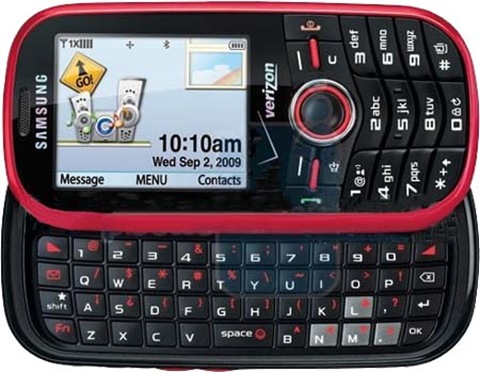This Homely FeaturePhone Is Almost As Popular As The iPhone. Really.
Even its fans admit that the Samsung Intensity is about as ugly as they come.
Yet, the Intensity was only a shade behind Apple's iPhone 3GS in first-quarter U.S. sales, according to market researcher, NPD. Yes, the mighty iPhone.
The Intensity ranked ahead of Motorola's Droid and plenty of other smartphones. RIM's BlackBerry Curve smartphone did take the top spot, though Silicon Alley Insider noted this wasn't exactly fair: the Curve is offered by multiple carriers in the U.S. while the Intensity and iPhone are offered by only one carrier (Verizon and AT&T, respectively).
So if featurephones are so lame, why did the Intensity and another model, LG's fifth-ranked enV3, sell so well as recently as 4 months ago?
That classic William Gibson quote explains it: "The future is already here - it's just not evenly distributed."
Smartphones, even Superphones, are already here, with their PC-in-a-pocket capabilities.
But most Americans are more practical. They don't NEED a whole PC stuffed in their pants or purse. That's what their desktop at work or their laptop at home is for.
At least, the Intensity's popularity shows that Americans are thriftier and practical than usually given credit for.They just want to talk and send text messages. So they still prefer featurephones that are, compared to smartphones, light on features (they won't use), light in their pocket and, crucially, light on their pocketbook.
That describes my wife to a tee. She has owned an enV3 since late last fall. At the time, it seemed like a major upgrade. My wife hates talking on the phone, and she's busy taking care of our young kids. So for 4 years, she thriftily put up with a prepaid TracFone that was best described as a CripplePhone.
Nine months in, we've discovered the many limitations of the enV3: how painful it is to surf the Web. Or how pitiful the selection of apps and games is.
Not that it bothers her: the enV3 is attractive, rocks at texting and most importantly, doesn't require a $30-a-month data plan.
The same goes for the Intensity. Silicon Alley Insider described the Intensity thusly: "doesn't do apps and does the web poorly...doesn't come standard with mobile e-mail and it can't download music over the air. While the Droid 'does', perhaps the Intensity should be marketed as the phone that 'doesn't'."
Verizon is offering the Intensity online for free with a two-year contract. A texting plan is a necessity, but not a full-fledged data or e-mail plan ala any iPhone, BlackBerry or Android phone.
What are the implications? For one, that texting is gonna be huge for years to come (see the linked chart in the earlier part of this sentence on texting's popularity among teenagers if you don't believe me). That means SMS-based m-commerce is no legacy technology, but has a long runway ahead of it. It also means that as much criticism as Microsoft got for its failed Kin dumphones, it was actually onto something with its vision of consumer, especially teen, tastes. The big problem was that Verizon charged a hefty data plan for the Kin, something other phones aimed at this segment do not.
Finally, I'd add that the Korean manufacturers Samsung and LG who absolutely dominate the featurephone market in the US (Nokia being a small player here) are in a good position. For all the hype around HTC, these guys still seem to know what consumers still want.
